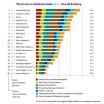WSU researchers use 3-D printer to make parts from moon rock
Coming to a natural satellite near you
2012-11-28
(Press-News.org) PULLMAN, Wash. - Imagine landing on the moon or Mars, putting rocks through a 3-D printer and making something useful – like a needed wrench or replacement part.
"It sounds like science fiction, but now it's really possible," says Amit Bandyopadhyay, professor in the School of Mechanical and Materials Engineering at Washington State University.
Bandyopadhyay and a group of colleagues recently published a paper in Rapid Prototyping Journal demonstrating how to print parts using materials from the moon.
Bandyopadhyay and Susmita Bose, professor in the School of Mechanical and Materials Engineering, are well known researchers in the area of three-dimensional printing, creating bone-like materials for orthopedic implants.
In 2010, researchers from NASA initiated discussion with Bandyopadhyay, asking if their research team might be able to print 3-D objects from moon rock. Because of the tremendous expense of space travel, researchers strive to limit what space ships have to carry. Establishment of a lunar or Martian outpost would require using the materials that are on hand for construction or repairs. That's where the 3-D fabrication technology might come in.
Three-dimensional fabrication technology, also known as additive manufacturing, allows researchers to produce complex three dimensional objects directly from computer-aided design (CAD) models, printing the material layer by layer. In this case, the material is heated using a laser to high temperatures and prints out like melting candle wax to a desired shape.
To test the idea, NASA researchers provided Bandyopadhyay and Bose with 10 pounds of raw lunar regolith simulant, an imitation moon rock that is used for research purposes.
The WSU researchers were concerned about how the moon rock material, which is made of silicon, aluminum, calcium, iron and magnesium oxides, would melt, but they found it behaved similarly to silica. And, they built a few simple shapes.
The researchers are the first to demonstrate the ability to fabricate parts using the moon-like material. They sent their pieces to NASA.
"It doesn't look fantastic, but you can make something out of it," says Bandyopadhyay.
Using additive manufacturing, the material could also be tailored, the researchers say. If you want a stronger building material, for instance, you could perhaps use some moon rock with earth-based additives.
"The advantage of additive manufacturing is that you can control the composition as well as the geometry," says Bose.
In the future, the researchers hope to show that the lunar material could be used to do remote repairs.
"It is an exciting science fiction story, but maybe we'll hear about it in the next few years," says Bandyopadhyay. "As long as you can have additive manufacturing set up, you may be able to scoop up and print whatever you want. It's not that far-fetched."
###
The research was supported by a $750,000 W.M. Keck Foundation grant. END
ELSE PRESS RELEASES FROM THIS DATE:
Treating cocaine dependence: A promising new pharmacotherapy
2012-11-28
Philadelphia, PA, November 28, 2012 – Medication development efforts for cocaine dependence have yet to result in an FDA approved treatment. The powerful rewarding effects of cocaine, the profound disruptive impact of cocaine dependence on one's lifestyle, and the tendency of cocaine to attract people who make poor life choices and then exacerbate impulsive behavior all make cocaine a vexing clinical condition.
In this battle, many candidate pharmacotherapies have been tested, but none have succeeded sufficiently to be adopted widely. Perhaps like cancer, heart disease, ...
Brain cell transplants in early 2013
2012-11-28
As part of the European study TRANSEURO, five patients with Parkinson's disease will undergo brain cell transplants at Skåne University Hospital in Lund, Sweden, in early 2013. These are the first operations of their kind in Europe for over 10 years.
The TRANSEURO study, which in Sweden is led by Lund University, is now taking a critical approach to the viability of cell therapy as a future treatment for Parkinson's disease. Can we replace cells that die as a result of our most common neurological diseases? What are the therapies of the future for neurodegenerative diseases ...
Report finds Big Pharma is doing more for access to medicine in developing countries
2012-11-28
Amsterdam, the Netherlands: The latest Access to Medicine Index, which ranks the top 20 pharmaceutical companies on their efforts to improve access to medicine in developing countries, finds that the industry is doing more than it was two years ago, with GlaxoSmithKline still outperforming its peers, but an expanding group of leaders closing the gap.
The Index, published Wednesday, found that Johnson & Johnson was one of the most dramatic risers, climbing from the middle of the field in 9th position in the 2010 Index to 2nd this year, closely behind GlaxoSmithKline. It ...
Anthropological expertise facilitates multicultural women's health care
2012-11-28
Collaboration between medical and anthropological expertise can solve complex clinical problems in today's multicultural women's healthcare, shows Pauline Binder, a medical anthropologist, who will present her thesis on 1 December at the Faculty of Medicine, Uppsala University, Sweden.
Pauline Binder has applied in-depth medical anthropological research approaches to understand clinical problems in ways not possible using only statistics. Why pregnant Somali women have an increased risk of complications even after migration has been the starting point for her fieldwork. ...
Researchers identify ways to exploit 'cloud browsers' for large-scale, anonymous computing
2012-11-28
Researchers from North Carolina State University and the University of Oregon have found a way to exploit cloud-based Web browsers, using them to perform large-scale computing tasks anonymously. The finding has potential ramifications for the security of "cloud browser" services.
At issue are cloud browsers, which create a Web interface in the cloud so that computing is done there rather than on a user's machine. This is particularly useful for mobile devices, such as smartphones, which have limited computing power.The cloud-computing paradigm pools the computational ...
Graphite experiment shines new light on giant planets, white dwarfs and laser-driven fusion
2012-11-28
An international team led by researchers from the University of Warwick and Oxford University is now dealing with unexpected results of an experiment with strongly heated graphite (up to 17,000 degrees Kelvin). The findings may pose a new problem for physicists working in laser-driven nuclear fusion and may also lead astrophysicists to revise our understanding of the life cycle of giant planets and stars.
The researchers were attempting to get a better understanding about how energy is shared between the different species of matter, especially, how it is transferred from ...
Family's economic situation influences brain function in children
2012-11-28
Children of low socioeconomic status work harder to filter out irrelevant environmental information than those from a high-income background because of learned differences in what they pay attention to, according to new research published in the open access journal Frontiers in Human Neuroscience.
Numerous studies in the past few years have begun to reveal how poverty affects brain development and function. In 2008, Amedeo D'Angiulli of Carleton University in Ottawa, Canada and his colleagues used electroencephalography (EEG) to measure the brain wave patterns associated ...
Virginia Tech scientists discover record-breaking black hole energy blast
2012-11-28
Virginia Tech physics researchers have discovered a quasar with the most energetic outflow ever, a finding that may answer questions about how the mass of a galaxy is linked to its central black hole mass and why there are so few large galaxies in the universe.
Researchers studied the quasar known as SDSS J1106+1939 in great detail using the European Southern Observatory's Very Large Telescope in Paranal, Chile – the world's most advanced visible-light astronomical observatory, and found the most energetic quasar outflow ever discovered.
The rate that energy is carried ...
Attitudes towards security threats uncovered
2012-11-28
New research has revealed a significant gap between what the government claims are the biggest security threats facing the UK and the fears of the population.
Terrorism is not perceived as the most important threat to everyday life despite claims by policy makers.
Politics researchers at the Universities of Warwick and Exeter led detailed focus groups across the UK and conducted a nationwide survey as part of an Economic and Social Research Council (ESRC) funded project which looked at public attitudes towards security threats.
Since 2005, key objectives of successive ...
Young adults more likely to smoke cannabis than drink before driving, 2011 CAMH Monitor survey shows
2012-11-28
For Immediate Release – November 28, 2012 – (Toronto) – Most adults are drinking responsibly, and fewer are smoking or using illicit substances – but several areas of concern were found in the 2011 CAMH Monitor survey of Ontario substance use trends, released today by the Centre for Addiction and Mental Health (CAMH).
"More young adults are reporting that they drive within an hour of using cannabis - even more than those who report drinking and driving," says Dr. Robert Mann, CAMH Senior Scientist and lead researcher. "Yet the risks of doing so are significant." Nine ...
LAST 30 PRESS RELEASES:
American College of Cardiology comments on new dietary guidelines for Americans
American Society of Gene & Cell Therapy and Orphan Therapeutics Accelerator partner to advance and commercialize promising rare disease treatments
One in 14 patients having day case surgery have new or worse chronic pain 3 months after their operation
New study highlights link between eviction rates and gun violence
Heatwaves heat up soil but not toxin levels in rice, study finds
Digital modeling reveals where construction carbon emissions really come from
Turning farm waste into water filters
New study shows how the spleen helps the immune system accept a transplant
New Mayo Clinic study advances personalized prostate cancer education with an EHR-integrated AI agent
Researchers identify novel therapeutic target to improve recovery after nerve injury
Microbes in breast milk help populate infant gut microbiomes
Reprogramming immunity to rewrite the story of Type 1 diabetes
New tool narrows the search for ideal material structures
Artificial saliva containing sugarcane protein helps protect the teeth of patients with head and neck cancer
Understanding the role of linear ubiquitination in T-tubule biogenesis
Researchers identify urban atmosphere as primary reservoir of microplastics
World’s oldest arrow poison – 60,000-year-old traces reveal early advanced hunting techniques
Bristol scientists discover early sponges were soft
New study uncovers how rice viruses manipulate plant defenses to protect insect vectors
NSF–DOE Vera C. Rubin Observatory spots record-breaking asteroid in pre-survey observations
Ribosomal engineering creates “super-probiotic” bacteria
This self-powered eye tracker harnesses energy from blinking and is as comfortable as everyday glasses
Adverse prenatal exposures linked to higher rates of mental health issues, brain changes in adolescents
Restoring mitochondria shows promise for treating chronic nerve pain
Nature study identifies a molecular switch that controls transitions between single-celled and multicellular forms
USU chemists' CRISPR discovery could lead to single diagnostic test for COVID, flu, RSV
Early hominins from Morocco reveal an African lineage near the root of Homo sapiens
Small chimps, big risks: What chimps show us about our own behavior
We finally know how the most common types of planets are created
Thirty-year risk of cardiovascular disease among healthy women according to clinical thresholds of lipoprotein(a)
[Press-News.org] WSU researchers use 3-D printer to make parts from moon rockComing to a natural satellite near you

